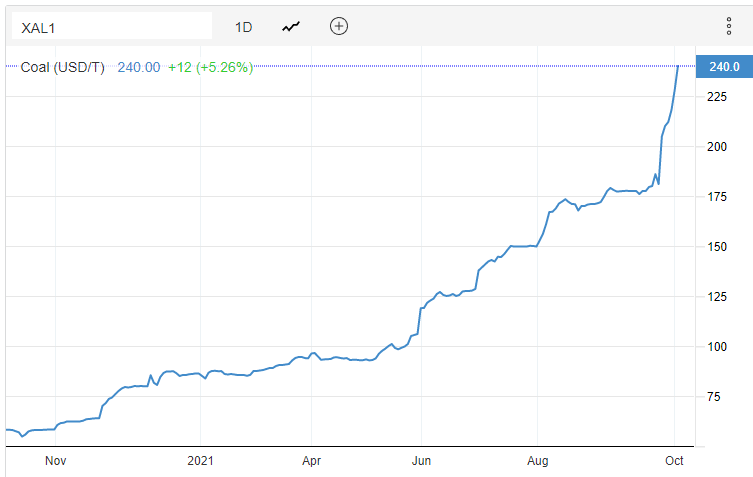Coal Gone Wild
October 4, 2021
by William P. Meyers
Popular pages:
| U.S. War Against Asia |
| Fascism |
| Democratic Party |
| Republican Party |
| Natural Liberation |
Unpalatable Alternatives to Stopping Global Warming
Coal ended today at $240, up 314% from $58.10 one year ago, as shown in the following chart. [figures are dollars per metric ton]

Source: https://tradingeconomics.com/commodity/coal
How can the price of coal have gone up so much when nations are supposed to be cutting back on coal? Using it to generate power (or heat) produces more carbon dioxide, and hence global warming, than any other source. The price should be dropping as we all switch to renewable power sources.
The immediate causes are easy enough to understand, but the full answer is complex. Coal is a commodity, sold internationally, that responds to the usual law of supply and demand. Supply slumped in the last few years, particularly in the advanced nations like the U.S., Britain, and Germany. Demand has shot up since 2020, resulting in those who need coal bidding up the price.
Demand has shot up for two reasons. One is demand for energy continues to rise as nations with large populations of low-energy consumption people, third-world nations as well as still large proportions of nations like India, see those people wanting the luxuries of advanced nation living, like air-conditioning, convenient heat, lighting, and electronic devices. Alternatives to coal are not working out well right now. Several nations, notably Germany and the U.S., have been taking out nuclear power plants. The main commodity that was replacing coal is natural gas, and its own price has shot up dramatically this year. Solar and wind power are not being added quickly in the large scheme of things. And, interestingly, but seldom mentioned by their environmental advocates, it takes coal (a kind called coke) to make silicon for solar cells and steel or aluminum for turbines.
Given the high current price, miners have an incentive to produce more coal, but they are going to be careful about that. They don't want to invest a lot of capital if the price is just going to come back down in a year or two. And it could, if something reduces the overall demand for power, like a global depression.
A lot of environmentalists hate natural gas because of the fracking process now used to gather it. Natural gas is composed of carbon and hydrogen, so when burned it creates some carbon dioxide, but the hydrogen burns to form water. Natural gas seemed plentiful, and was cheaper than coal for a long time, but as utilities converted to using it, demand drove the price up [natural gas price chart].
Underlying all of this demand, in addition to poorer people wanting more comfortable lives, is the continued increase in global population. If demand goes down 10%, but the population goes up 10%, we end up with just as much CO2 going into the air. The problem is that currently the trend is that both are going up. Tinkering with the various sources of energy does not help much against that double whammy.
It is not that politicians, citizens, and even industrialists do not understand the seriousness of the global warming problem. But politicians who say they will give people less quickly become ex politicians. So what they mostly do, even the environmentalists in the Democratic Party and Green Party, is promise higher incomes for not-rich people, and lower carbon dioxide emissions. Those two promises are incompatible. The windmill and solar industries claim they can manage both, but they are lying or deluding themselves. At some point paving the world with solar cells is more destructive than having smaller more conventional electricity plants. Pick your poison, but stop telling people it is a cure for the cancer of human overpopulation.
In some semi-developed nations, and third-world nations, politicians have realized their own country has reached a limit, and have taken serious steps to try to stop or even reverse population growth. Those cases are exceptions. The only thing that will really work is a global one-child policy. That seems, so far, to be politically impossible. Even the Green Party in the U.S., at least when I was active in it, would not endorse a one-child policy. The best the Democrats will do is try to make sure contraception and abortion are universally available. At the same time the progressives and socialists, who have come to be the dominant faction, are determined to give low-income Americans higher income. It does not matter what we spend it on, it will increase carbon dioxide emissions and ecological destruction. Suggest paying low-income families to not have children (meaning have just one) and you will get hooted out of the room as a racist. Even though [fact] there are many more low income white families in America than black ones.
I expect the Slow Motion Apocalypse to keep rolling forward, albeit at an unpredictable pace. For people a century from now the best case scenario is a big die off of the human population soon, which could allow the earth to start healing, a process that will take centuries. More likely we will be governed to Murphy's Law 2.0: what can go wrong will go wrong, but in a way that maximizes ecological destruction before humans die off.
| Copyright 2021 William P. Meyers. All rights reserved. |
